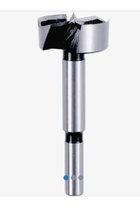Doug, this is my presumption and not based on any research. That said, I believe the Darex grinder was made for the machine shop to make resharpening of drill bits fast and accurate, and with no strong skill required by the sharpener (i.e., vs. the machinist who sharpens by hand). For that, it works remarkably well, and achieves a very good edge quickly.
My understanding of the split point grind is that it effectively achieves the same cutting end as the 6-facet grind (the tertiary facets are extra relief behind the secondary facets). It also allows for a larger primary facet.
The pictures below show a drill bit from the end. The bit would revolve counter-clockwise when viewed from this angle.
The Secondary Facet has a clearance angle of 7-14 degrees. The Tertiary Facet would be 20-30 degrees or so from the Secondary Facet.

I broke a drill bit recently and tried to regrind the remaining part to be a short bit. What I found was that the center was not as hardened as the outer part, and the result was a bit which had to be discarded. It was like a piece of punky wood at the center of the heartwood.
What surprises me is that the Darex does not also grind a secondary point angle. Joseph Mazoff documented how that additional grind reduced the power required for drilling. Possibly better materials in tooling has reduced the need for such.
By the way, the latest-and-greatest Darex is a CNC machine which retails for $30K!
I must add one thought about sharpening of drill bits. The benefits of doing this are certainly that you can get more life out of your investment in good drill bits. But one must also look at the real benefit to the materials.
When I am boring very expensive or rare woods, I always ensure the bits are sharpened and honed. This helps to prevent the build-up of heat, and helps to reduce the chance of blow-out as I exit the piece. For these materials, I will sharpen the drill bit(s) on the diamond wheels, finish on the Japanese stone, and then hone the flutes on the leather wheel.
As Bill Boehme noted, this is very doable on a Tormek with the DBS-22 jig. It is not cheap, but no where near the cost of a Darex.
As a retiree, my time is cheap; excellent wood is not.








